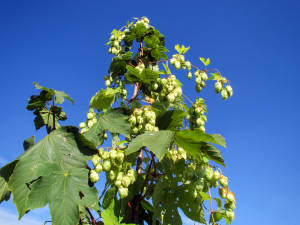Hops is a hardy perennial plant that is popular as a decorative plant as well as a key ingredient in beer. Many people will have reached this page interested in having their own supply of hops for home brewing. The good news is that it is an easy plant to grow in almost any climate. The bad news is that if growing from seed it takes 2 to 3 years before you know the gender of the plant (beer is made from the un-pollinated female plant). For this reason, hops are generally grown from rhizomes, which are cuttings of roots from other plants.
Hops take a little while to get going, so they are not for the casual home brewer. It takes about 3 years for the plant to provide a few pounds of hops for home brewing. The first year is devoted to establishing roots only.
How To Grow Hops
Hops prefers cool temperate climates. It needs free draining soil and a sunny position. The soil should be dug deeply. Hop vines grow up to 25 feet, so you had better make sure there’s a lot of room for them. Some sort of support/trellising is required to keep the vines up off the ground and disease free. This can be a specialist gardener’s trellising (lattice is the best option), or simply a piece of rope for the vine to grow up. The rope makes harvesting especially easy. Attach the rope from a point near where the rhizome is planted to the house or another tree.
Buy a rhizome from a specialist grower or plant store. It should be stored in the refrigerator until it is ready to use.
Prepare the soil a month before planting by digging through well-rotted manure. This will ensure the soil is rich and fertile, as hops use a lot of nutrients. Hops need about 4 months free of frost to go in to flower, but don’t like extremes of heat, so plant at the appropriate time for your climate. Coming out of winter in frosty areas or early autumn in frost-free areas is about right.
Plant rhizomes about 2 inches deep with the buds pointing upwards. If there are no buds, just plant the rhizome horizontally. Plant each rhizome 2 feet (60cm) apart, or 5 feet (1.5m) apart if you are growing multiple different varieties of hops.
Hops grow at an astonishing rate. You will need to take the attitude of a military drill commander when growing hops. If they step out of line for a second, thin them. You should really only have 2-4 vine shoots coming off of each rhizome, or else they will be difficult to harvest.
They need help to entwine themselves around the trellising. Once the vines are long enough, start to curl them around your trellising. The plant will continue to grow upwards with time.
Growing Hops In Containers
Hops can be grown in containers easily. They need a large container and something to grow up. The diameter of a pot should be at least 12 inches. Placing trellising next to it or in the center of the container is advisable to prevent it from falling over.
Harvesting and Storing Hops
Hop leaves can be picked as the plant grows. Hop cones should be picked when they are dry like paper and green. The taste is sub-optimal if they have turned brown. If you have grown hops up anything that can’t be cut down (rope or string), you will probably need to get up on a ladder to get the uppermost ones.
Once harvested, dry the hops out. The cheap and nasty way to do this is to use a tray of some sort, spread the cones over the tray and run hot air over them using a fan or air conditioner. Be sure to turn the cones at least once to target the other side. They take about a day to dry out using this technique.
Once dry, they can be stored in the freezer in airtight bags.
Threats To Hops
Hop wilt is a disease that is relatively common. The leaves appear dull green with yellowy bands. There is no solution – you will have to dig up your plant, burn it and not plant hops in that area again.
Downy mildew occurs every so often. The leaves appear silvery on top. Remove the leaves as soon as possible once noticed. Downy mildew thrives in moist environments.
Aphids occasionally get to hops as well. They can be controlled by hand removal or via insecticide.



